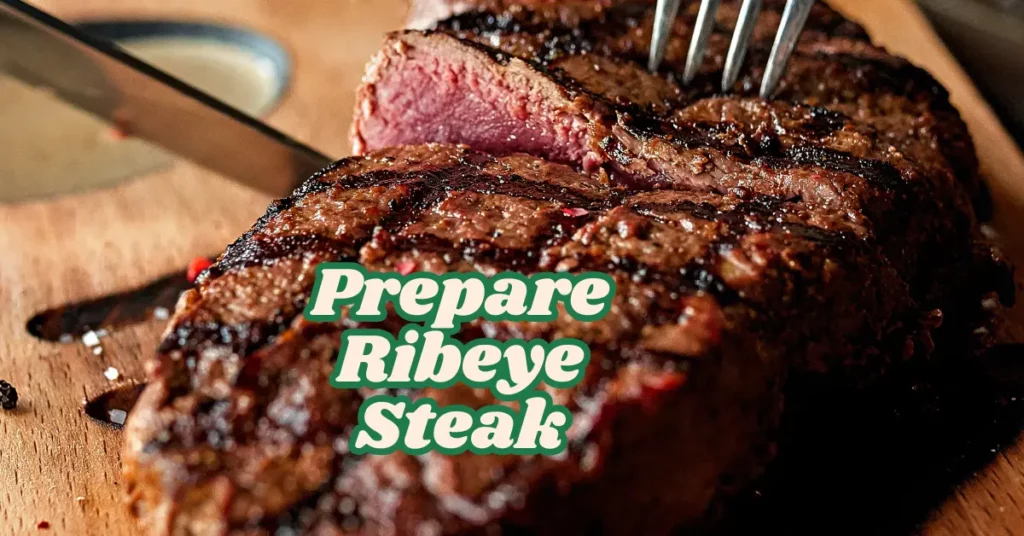This post may contain affiliate links. If you use these links to buy something we may earn a small commission. Thanks.
Few things rival the satisfaction of a perfectly grilled ribeye steak. With its rich marbling, bold beefy flavor, and melt-in-your-mouth tenderness, ribeye is a grill master’s dream. But before you throw that beautiful cut on the grill, proper preparation is essential. From choosing the right steak to seasoning and getting your grill prepped, each step plays a key role in the final flavor and texture.
In this guide, we’ll walk you through everything you need to know to prepare ribeye steak for grilling like a pro. Whether you’re a seasoned backyard chef or a weekend warrior, mastering the prep is your first step toward steak perfection.
Choosing the Right Ribeye Steak
Bone-In vs. Boneless
One of the first decisions to make when selecting a ribeye is whether to go with bone-in or boneless. Bone-in ribeyes, often called cowboy steaks or tomahawks (when the rib bone is long), tend to offer slightly more flavor due to the marrow and added moisture retention during grilling. Boneless ribeyes, however, are easier to manage on the grill and cook slightly faster. Both are delicious; your choice depends on personal preference and how confident you feel flipping around a steak with a rib handle!

Marbling and Grade
Marbling refers to the thin streaks of fat interspersed throughout the meat. This intramuscular fat melts as the steak cooks, infusing it with flavor and juiciness. When shopping, look for cuts labeled USDA Prime for the highest marbling and tenderness. USDA Choice is a step below but still excellent. Select cuts may be leaner but can dry out if not handled carefully.
Thickness Matters
A thick steak is key to getting a flavorful sear while maintaining a juicy interior. Aim for steaks that are at least 1 to 1.5 inches thick. Thinner cuts may cook too fast and make it hard to get a nice crust without overcooking the inside.
Fresh vs. Frozen
Fresh steaks are always ideal, but frozen ones can be just as tasty if thawed properly. Always thaw frozen ribeye slowly in the refrigerator for 24 hours. Avoid thawing at room temperature or using the microwave, as this can cause uneven texture and compromise safety.
Tools and Ingredients You’ll Need
Essential Tools
- A reliable grill (gas or charcoal)
- Tongs (never a fork that punctures the meat)
- Instant-read meat thermometer
- Cutting board and sharp knife
- Paper towels
Key Ingredients
- High-quality ribeye steak
- Kosher salt and freshly ground black pepper
- Optional: garlic powder, onion powder, smoked paprika
- Optional: fresh herbs (rosemary, thyme), unsalted butter, olive oil
Prepping the Steak
Bring to Room Temperature
Before anything hits the grill, your steak needs to rest at room temperature for about 30–45 minutes. This allows the meat to cook more evenly and helps develop a better sear.
Pat Dry for a Better Sear
Moisture is the enemy of browning. Use paper towels to thoroughly dry the surface of your ribeye. A dry steak will form that beautiful golden-brown crust that adds so much flavor.
Trimming Excess Fat
While you want to keep most of the fat for flavor, sometimes a ribeye can have thick exterior fat that won’t render fully on the grill. Trim down any large, hard pieces, but leave the marbling and soft fat intact.
Seasoning
You don’t need a cabinet full of spices to make an incredible ribeye. A generous coating of kosher salt and freshly cracked black pepper is often all you need. Apply it liberally to all sides of the steak. If you’re feeling adventurous, you can add a sprinkle of garlic powder, onion powder, or smoked paprika for extra depth.
Optional Pre-Grill Enhancements
Dry Brining
Dry brining is one of the most effective ways to boost flavor. Simply season your steak with salt and let it rest uncovered in the fridge for 1–24 hours. The salt penetrates deep into the meat, improving both texture and taste. When ready to grill, remove the steak and let it come to room temperature as usual.
Marinade Tips
Although ribeye is rich enough on its own, some prefer to use a marinade. If so, choose ingredients that complement, not overpower, the beef think olive oil, balsamic vinegar, garlic, and herbs. Marinate for no more than 2–4 hours, as too much acid can break down the fibers and turn the steak mushy.
Compound Butter Prep
Want to take your steak to the next level? Whip up a garlic herb compound butter in advance. Mix softened butter with minced garlic, chopped parsley, thyme, and a pinch of salt. Roll it into a log and refrigerate. After grilling, place a slice on the hot steak for a luxurious finishing touch.
Preparing the Grill
Cleaning and Oiling the Grates
A dirty grill can sabotage all your prep work. Start with clean grates and preheat your grill. Once hot, use a grill brush to scrape off any residue. Dip a paper towel in oil and use tongs to wipe the grates. This prevents sticking and promotes grill marks.
Setting Up for Two-Zone Heat
The secret to grilling thick steaks is the two-zone method. On a gas grill, turn one burner on high and leave the other off. For charcoal, push hot coals to one side. This setup gives you a hot side for searing and a cool side for finishing the cook more gently.
Preheating the Grill
Give your grill at least 15 minutes to preheat. You want the hot side to reach about 450–500°F for a proper sear.
Final Preparation Before Grilling
Reapplying Seasoning (if needed)
If you’ve dry brined your steak or let it sit too long after seasoning, a second light sprinkle of black pepper can refresh the crust before grilling. Salt should already be present from your earlier prep.
Light Oil Coating on the Steak (Optional)
Some grillers like to rub a tiny bit of oil (like avocado or canola) on the steak itself to promote even browning. Be cautious too much oil can cause flare-ups.
Ready Your Tools
Make sure everything you need is within reach meat thermometer, tongs, timer, and a clean plate for resting the cooked steak. The actual grilling process moves quickly, and you don’t want to be scrambling.
Conclusion
Preparing a ribeye steak for the grill is about more than slapping meat on flames. It’s an intentional process that starts with selecting a quality cut and continues through thoughtful seasoning and smart grill prep. Every small decision from how long you let the meat come to room temperature to whether you use compound butter contributes to the final result.
Now that your ribeye is prepped to perfection, it’s time to fire up the grill and put those techniques into action. Whether you’re cooking for a crowd or indulging in a solo feast, a well-prepared ribeye steak is guaranteed to impress. Happy grilling!
